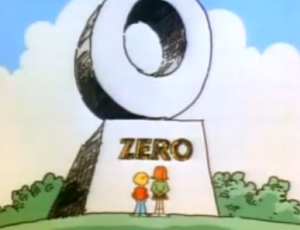 When we teach math at home, we start with the counting numbers. Then we move to either the homeschool or classroom setting and build on those with negatives. And zero is sometimes left behind.
When we teach math at home, we start with the counting numbers. Then we move to either the homeschool or classroom setting and build on those with negatives. And zero is sometimes left behind.
Zero seems to be an understood concept because it’s so much a part of our lives, as grownups. But zero is a very unusual bug.
Is Zero Positive?
We think of the numbers as either positive or negative.
But actually, all real numbers can be divided into three categories: positive, negative and zero.
This is one of the reasons zero can be forgotten in all this mix. With so many other numbers to be positive and negative, zero’s truly in a class by himself.
Notice I wrote “All real numbers can be divided into three categories.” Imaginary and complex numbers can’t be classified this way. You can order imaginary and complex numbers, but you have to do it without labeling them as positive or negative.
Why can’t we just say zero is positive?
I guess we could. But you might not want to when you see this…
In math, sometimes, we do things because if we didn’t, they’d mess everything else up.
This is one of those situations.
So let’s say 0 is positive, just for the minute.
Take the rule, “When multiplying, if the signs are different, the result is negative.” So then (positive) zero times negative 3 is (negative) zero. Like this:
0 x -3 = +0 x -3 = -0
But we determined that zero was positive!
So this messes things up. Therefore, zero needs to be in a class by himself.
But zero feels positive and negative, sometimes!
Indeed if a kid doesn’t owe his sister anything, that’s a positive feeling.
If you owe someone $3, then you can say you have negative 3 dollars. So if you owe them nothing, don’t you have a negative zero dollars?
This is more of a direction than a positive or negative sign. The “vector” (arrow in a direction) that has length zero can technically be pointing in any direction. It doesn’t matter. And that’s what’s going on when you think of zero as positive or negative. You think of owing (money going in a direction) nothing.
But remember, that’s only thinking of zero as positive or negative. He really isn’t either.
He’s just zero.
Check out the classic Schoolhouse Rock Multiplication Rock video and let me know what you think of all this zero talk.
http://youtu.be/Nvc2PPTlW7k
Related articles
- Teaching Math without Rules: Addition of Positive and Negative Numbers
- The Real Place Kids Learn Math
- How To Teach Algebraic Closure

This post may contain affiliate links. When you use them, you support us so we can continue to provide free content!







In some old computer programming languages zero could be positive or negative depending on which way you approached it.
Good point, Joshua!
And those are the same old languages that had the Y2K problem. 😀
Actually, It was not the language bug but the programming bug.
Well I guess that it is neither but it is hard to get it and hard to imagine
I can see that. Thanks for stopping by!
hogwash.. floating point has positive and negative zero. CPU’s have the same embedded (since about 486 and before them with co-processor). Your iphony gadget’s hardware and the computerlanguages that it’s software was programmed in have positive and negative floating point zero in them.
It has nothing to do with old computer languages and the computer languages have nothing to do with the y2k problem. It always is (and has been) programmer/specification limitation/error/misunderstanding!
And it wasn’t always just ‘naive’ coding either: some parts of code/libs/hardware were never intended to be still running 50 years after they were created, let alone handling mission critical tasks.
Take this rule to heart: Whenever one tries to solve ‘magic’ by using a lib that does ‘magic’ without having to understand ‘magic’ one ends up with ‘undefined’.
They aren’t just there for simplifying the machine-math either: A number of mathematical fields/domains (like limits, statistics and some others) NEED a positive and negative 0. They also represent the other end of infinity: the infinitesimals or expressing a mathematical UNDERflow (instead of overflow) due to rounding! A practical example is if the temperature is some infinitesimal value below 0, then it IS freezing (at -0 after rounding to a desired precision)!
Zero IS a special number but some of it’s properties are culturally/nationally chosen! The subsequent definitions are a result of these fundamental base choices.
In (for example) France and Belgium (including the Dutch speaking part called Flanders AND the German speaking part) the number 0 is “the only number whose polarity attribute is defined to be BOTH positive and negative”. This is NOT just a language thing regarding discrepancies in terminology to describe number-sets. They then add ‘strict’ to positive and negative when the number is not 0. As a result:
-0 is then the additive inverse of +0
Positive numbers are: >=0
strictly positive numbers are >0
Negative numbers are : <=0
strictly negative numbers are <0
signum function: return +1 for strictly positive numbers; return -1 for strictly negative numbers; otherwise return 0 (or +/-1 depending on mathematical field of usage)
etc…
One might say they are wrong, but as far as they are concerned the rest of the world got it wrong. One might say they are a minority globally and then you correct. However (interesting to note) a growing number of math-users and sites like wikipedia and wikimath are suggesting to add 'strictly' to the common positive and negative terminology as it doesn't conflict with the common 'zero has no polarity'-based definitions (and might invite users to wonder 'what then are non-strict polarities' to which the answer is: 'we don't have them, but it's the number 0 in countries like France and Belgium').
Never forget, mathematics are ONLY a universal language as long as you explicitly and unambiguously DEFINE EVERYTHING you say.
thanks a lot! it helped me with my homework!!:)
To determine the “range” between negative 3 and positive 3, the answer is 7, not 6, right?